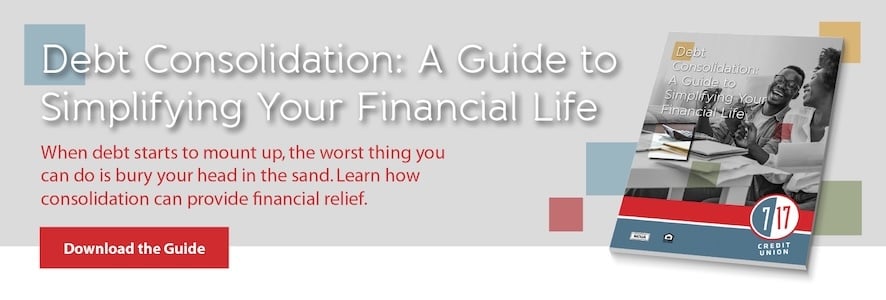- 7 17 Staff
Top 6 Tips for Managing Your Debt

Carrying debt can feel overwhelming, and the worst thing you can do when it starts to pile up is to ignore it. Even though your debts may seem insurmountable, you still have options for managing debt and getting things under control. Let’s take a look.
Is There Such a Thing as Good Debt?
Just hearing the word “debt” can bring up negative feelings. But believe it or not, there are some types of good debt.
Debt may be considered beneficial if it helps you build wealth. For example, unless you purchase a house with cash, you’re going into debt with a mortgage. This type of debt is good because it helps build wealth and equity and can significantly improve your life. Tuition costs and funding a business are also considered good debts because of the future benefits to your wealth.
Many other kinds of debts are considered bad because they aren’t healthy for your finances. One of the largest bad debts is credit card debt, especially if it’s high interest. Carrying too much of this type of debt can impact your credit score.
What Is Debt Management?
Debt management gets your debts under control with budgeting and financial planning. The goal of debt management is to lower your debts and work toward eliminating them completely.
You can either come up with a plan for managing debt yourself, or you can seek credit counseling assistance. There isn’t one right answer to which method is best. Creating a plan on your own can be the simplest, but having a partner in accountability or negotiation assistance can be a valuable asset.
Top Strategies for Managing Debt
Managing debt can often feel challenging. Here are some strategies to better manage and repay your debts.
1. Pay more than the minimum.
Try to pay more than the minimum due each month. This pays down your debts faster, saves on interest and possibly increases your credit score. However, if you’re going to put extra money toward a debt (such as in our next strategy), it can help to just make the minimum payment to focus on one debt at a time.
2. Use the debt snowball or avalanche method.
First, start by making a list of your debts and the balance you have on each, from smallest to largest. With the debt snowball and debt avalanche methods, you’re going to put as much extra money as you can into one debt until it’s paid off.
If you’re pursuing the snowball method, then you’ll start with the smallest debt balance. If you’re pursuing the avalanche method, then you’ll start with the highest interest rate. Then, you’re going to move on to the next debt on your list and put as much as you can plus whatever the minimum payment was on your previous debt onto this debt.
3. Consider debt consolidation.
Debt consolidation simplifies the process of managing debt by consolidating several payments into one. There are a few ways to do this, including personal loans and balance transfer credit cards.
If you pursue a balance transfer credit card, you’ll only be able to transfer balances from cards that aren’t through the same company. Often, you may be able to get a low or 0% promotional rate that generally lasts between 12-18 months. However, you’ll want to aim to pay off the card within that time frame to avoid interest capitalization.
If you pursue a loan, you’ll pay off as many debts as you can with the amount you received from the loan, and then only pay on the loan. However, it’s important to avoid using your credit cards after you’ve paid them off because otherwise you’ll create even more debts.
4. Avoid using credit cards.
The more you use credit cards, the more your debts will pile up and create a feeling that they are overwhelming and insurmountable. Instead of reaching for your credit card, use cash or your debit card when you can. If you need to put a purchase on your credit card just to keep it active, pay off the purchase right away to prevent your balance from rising.
5. Avoid opening new accounts.
Having a lot of credit accounts with balances can hurt your credit score and also make it more difficult to manage. Only apply for and open new accounts if you truly need them.
6. Monitor your credit score.
Regularly check your credit reports and scores to ensure they’re accurate, and evaluate areas where you can improve.
Simplify Your Debt Management
Many people dream of being debt-free someday. One of the methods of achieving this is through debt consolidation, which can simplify your debts. Find out more about debt consolidation and how it can give you a clearer path to eliminating your debts by downloading our free resource, “Debt Consolidation: A Guide to Simplifying Your Financial Life.”
